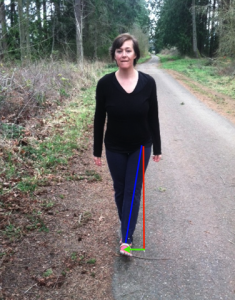This post from 2013 was edited, updated, and expanded in 2020. This is one out of a handful of our favorite articles on walking, including topics covering what various “walking parts” do as well as other whole-body considerations. Find the rest of them in the walking section of Our Favorite Feet, Footwear, and Walking Resources.

I get a lot of questions on "saddlebags," a barfy term for mass mysteriously accumulating on the outside of the hips, even on those that exercise regularly. The thing is, I don't find them that mysterious at all, when I consider how common the muscle weakness of the lateral hip can be. And, P.S. I have no problem with the appearance of things, thighs included. I do care about lateral hip weakness though, when it comes to walking well and the strength and longevity of the knees, hips and pelvic floor.
Anatomical terminology lesson #1: When you're standing on one leg and you bring the floating leg towards the midline, this medial movement of the thigh is called adduction.
The red line is where my leg was, the blue is where it is now and the green arrow shows the direction of movement. The gray hairs mean nothing, so don't be confused.
Anatomical terminology lesson #2: When you land on one leg while walking, and you find your pelvis moving laterally (towards the pinkie toe) relative to your planted foot, this too is called adduction.
{Once again, I am blown away by my ability to create professional-grade teaching images in minutes. MINUTES, I say!}
Biomechanics Lesson #1: In the case of the first picture,
it was the muscles of my inner thigh, cleverly named the adductors, that initiated the movement. Also known as ACTIVE adduction.
Biomechanics Lesson #2: In the case of the second picture,
it was gravity powering the displacement of my skeleton, the end result being hip adduction. PASSIVE adduction in this case. During passive movements, both muscles and joints move though there is no muscular/local work.
In today's lesson I strive to highlight why it's not a great idea to memorize which muscles do what when it comes to anatomy. Those lists in anatomy books are situation-dependent and most of the time that situation is not explained nor is it taught in these books how to figure out what's working (or not) in different loading situations. Which is why I like to teach mechanics (how it works) first and anatomy (where it is and what it's called) second.
So you're not interested in anatomical science but are interested in what this means for you: When you're walking and your pelvis radically shifts from right to left, this is an indication that your lateral hips are not strong enough to carry the weight of your body. To train the lateral hip, start by working on your pelvic listing to improve your awareness of this muscle and what it does.
Then, put it into real-life practice. The next time you're out walking, try to minimize that lateral deviation of your pelvis (read: the stance hip's adduction) by engaging your pelvic listing muscles and trying to avoid a major drop of the floating half of your pelvis. You'll likely need to walk with your feet closer to pelvis-width, which is a challenge at first but will become easier as you gain strength.
Here is another picture. A picture I imagine would be more helpful if I had put it in before-after order instead of the reverse. (MINUTES, I say!)
Note: The wider your pelvis, the greater (absolutely speaking) the drop. While pelvic listing might seem like more work for those of us with wide hips, wide hips are also equipped with muscle attachments that come with more leverage to even things out, mechanically speaking.
If you've got saddlebags (does anyone have a better word for this, please?) then check your pelvic list strength and gait. Then, you can learn more about the local lipolysis phenomenon by listening to (or reading the transcripts of) podcast episode #44: The Skinny on Fat.


